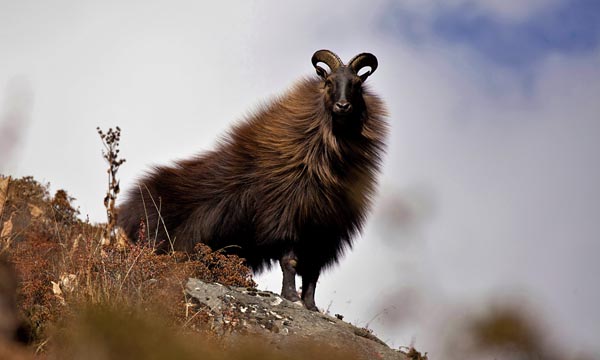Related Wildlife Species Founds in India
Lorem ipsum dolor sit amet, consectetuer commodo ligula eget dolor
Aenean massa Cum dis parturient montes.
Change language

Location :Chamoli (Uttar Pradesh)
Coverage area : 630 sq. Kms
Main attraction : Bharal, Himalayan Tahr
Best time to visit :
Nearby excursions : Josimath
Nearby cities :Chamoli
The second highest peak in India ? Nanda Devi nests in the Nanda Devi Biosphere Reserve. The NDBR got its name for being home to the 7817 m high peak. NDBR, located in the Himalayas, is one of the least disturbed protected areas globally. The region has always been in the news because of the many international adventures, political and socio-economic events that revolve around the region. The area is famous for having rich biodiversity which is supported by its unique natural landscape, distinct topography, climate, and soil.
In the year 1982, it was termed as a national park. It got the status of being a UNESCO World Heritage Site in the year 1988. The 6407.03 square kilometres wide area is divided into three zones - Core zones, Buffer Zone and Transition zone. The Valley of Flowers National Park and the Nanda Devi National Park are among the two core zones of the Nanda Devi Biosphere Reserve. These zones are highly protected for they have been declared as a World Network of Biosphere Reserves by UNESCO, in 2004. These regions don't have any human habitation. Tourists and
research activists are allowed in the Valley of Flowers National Park, around 6500 tourists visit this region every year. While the Nanda Devi National Park is open to the public, although only 500 tourists are allowed to enter the outer parts of the NDNP. The buffer zone is the area that surrounds the core zones from all the sides. The transitions zones are regions lying to the south of the buffer zone. The buffer zone and transition zone acts as a buffer area for human habitation to keep the core zones as a haven only for the animals and birds.
The National Ministry of Environment and Forests, India; along with the Uttarakhand State Forestry Department manage the Valley of Flowers. The trek to the Valley of Flowers National Park begins at Govindghat.
The NDBR conserves the biodiversity and nature in all three zones. It provides a safe home to the animals and plants, keeping them away from the human eyes.Visitors are only allowed to go to a limited area, and travellers need to obtain special permission from the Forest Department citing a good enough reason to go there.
The NDBR is situated in the state of Uttarakhand. It spreads over the three districts of Chamoli, Pithoragarh and Bageshwar. It lies between 79o 13? E to 80o17? E longitudes and 31o04? N to 30o06? N latitude. The altitude ranges from 1800 meters to 7817 meters. The Lata village has the entrance to the park. The park is surrounded by peaks from every side except the west where the Rishi Ganga Gorge is located.
The climate is the main reason why the vegetation and wildlife flourish in the Nanda Devi Biosphere Reserve. The climate is dry most of the year, while in monsoon; the region experiences heavy rainfall from June end to the beginning of September. The region is covered with snow in October to March. It snows heavily in the southern region of the valley compared to the northern side. In the summers the temperature is between 10oC to 23oC, while in the winters the temperature can stoop lower than 0oC and can go into negative.
Since the winters have an extreme temperature, the ideal time to visit NDBR would be in April to June. The weather is pleasant, with the sun showing its grace and warming up the place just right. This is the time when you'll get to see most of the animals. Even the month of October is a good month to travel to the Nanda Devi Biosphere Reserve.
Jim Corbett National Park
Pilibhit Tiger Reserve
Govind Pashu Vihar National Park and Sanctuary
Pin Valley National Park
Kishtwar National Park
Deosai National Park
Gangotri National Park
Rajaji National Park
Joshimath , 19 km
Srinagar ,163 km
Dehradun ,310 km
Rishikesh ,271 km
Chandigarh ,483 km
Delhi, 503 km
Indore ,1,250 km
Ahmedabad ,1,465 km
Mumbai ,1,944 km
Kolkata ,1,658 km
Hyderabad ,2,605 km
Bangalore,2,540 km
Chennai ,2,571 km
Airways
The nearest airport is the Dehradun (Jolly Grant) airport which is around 295 km away from the Park. From the airport, it is best to take a bus or book a car service, as the roads are well connected.
Railways
The nearest railway station is Rishikesh Railway station which is around 300 km away from the park. It is advisable to take a bus or book a car service from Rishikesh.
Roadways
The place is well connected to all the main roads. You can?t travel further than Joshimath by road.
Accommodation facilities
You can look up for a place on Airbnb in Joshimath as it is the closest city to NDBR. There are multiple resorts and hotels around the National Park. Some of these resorts are:-
The Tattva, 0.6 km away from the NDBR
The Royal Village - Auli Resort, 2 km away from NDBR
Clifftop Club, 2.9 km away from NDBR
The Garhwal Mandal Vikas Nigam Guesthouse
Things to do
Apart from visiting the national park and experiencing the wildlife at its best, there is a lot NDBR has to offer for the tourists, apart from the beautiful wildlife and biodiversity it nurtures, Nanda Devi Biosphere Reserve has a lot of activities for the tourists. One of the most popular activities is the Trek from Lata to Dharasi. There are other extreme sports like Paragliding that this place offers. You can do some wildlife photography as well.